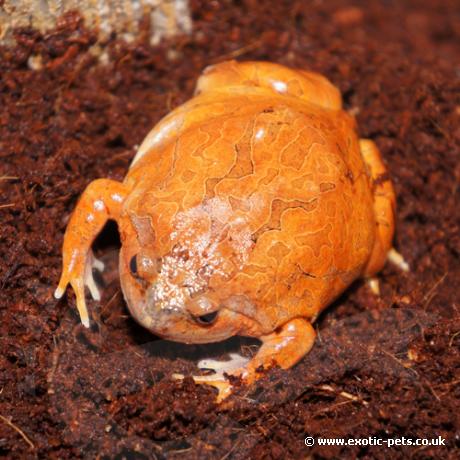

The Burmese Chubby Frog is a small species that reaches an adult size of 5cm. They can be found in Southeast Asia living within burrows and under leaf litter.
| Origin | Southeast Asia |
|---|---|
| Environment | Lowland Forests |
| Adults Size | 5cm |
| Suitability | Beginner |
| Lifespan | Unsure |
| Food Type | Variety of insects |
The Burmese Chubby Frog is similar to the Chubby Frog in their round fat-like appearance, however, their colour is different and they act differently. We mainly see various shades of orange, however, they can be light brown, we believe this may be due to where they have been collected from in the wild. They have a network of patterns on their back that are generally darker than their overall colouration. The belly and underarms are generally much lighter.
This species likes to burrow and will spend most of its time underground, waiting patiently for prey to walk past. They have reduced webbing on their back feet to help push into the substrate and when breeding in pools of water.
They are a small species reaching an adult size of approximately 5cm.
This species is found in Southeast Asia such as Myanmar, Thailand, Cambodia, Laos and Vietnam.
Inhabiting lowland forests close to rivers within the forest leaf litter, these are mainly seen when breeding occurs. In some areas, it is like an explosion of Burmese Chubby Frog as all frogs emerge from the ground to spawn. After this, they are rarely seen due to burrowing within the ground and only becoming active to feed.
To house 3-4 frogs, use a glass 60x45x30cm (24x18x12”). The substrate should be sand/soil mix to keep its shape while the frog burrows and hides. Place reptile-safe leaf litter over the substrate, moss, cork bark and artificial plants to give a natural and realistic appearance. Bio-active enclosures are also ideal for these frogs with live plants, springtails and isopods.
Provide low UVB lighting like a shadedweller, this will help simulate daytime hours. The temperature within the areas these frogs live in varies depending on the season however, with them living mainly underground we recommend providing heat of 21-24C (70-76F) with a slight drop at night. The heat source must be from above, use a deep heat projector or ceramic, we do NOT recommend heat mats. The heating unit will require a thermostat to prevent overheating and always have a thermometer within the enclosure.
Feed a varied diet of live insects; crickets, locusts, flies and earthworms every few days. Dust the insects on every feed with calcium or a vitamin supplement, please refer to the manufacturer's recommendations. When placing water in the enclosure, always treat this to remove harmful chemicals and metals in tap water. The use of a shallow water dish is ideal for this species.
cheap uggs cheap jerseys Christian Louboutin Shoes outlet Louis Vuitton handbags cheap uggs Louis Vuitton Louis Vuitton cheap Louis Vuitton